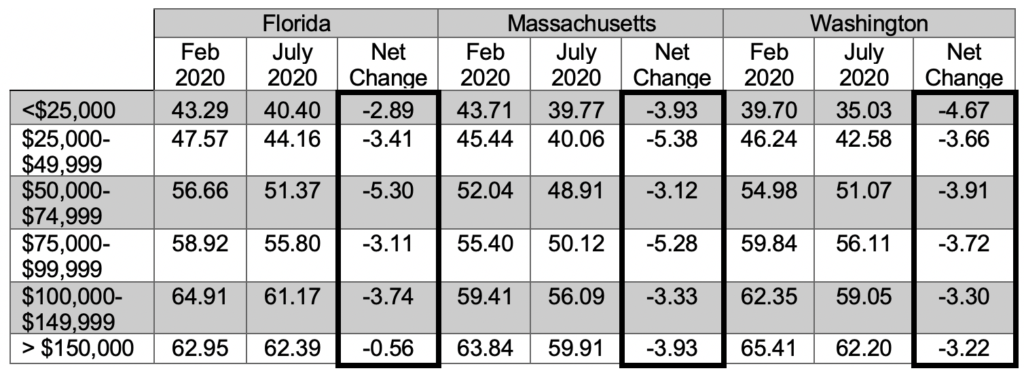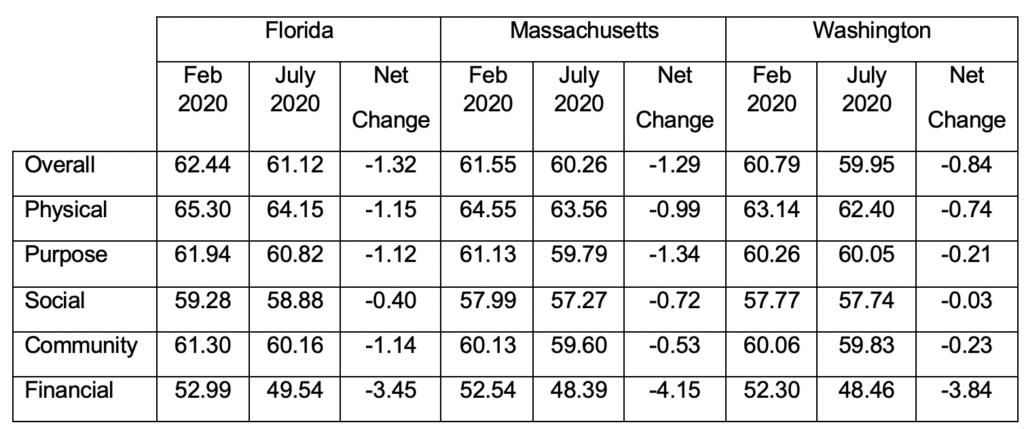Sharecare Study Reveals COVID-19’s Impact on Well-Being Across Three States With Differing Outcome Trajectories
COVID-19 has taken a serious toll on overall well-being and eroded financial security across the country—regardless of when community spread of the infection began or how local officials in each state responded to the pandemic, according to a retrospective study from Sharecare. The recent findings suggest, however, that Americans’ income level played a role in the degree to which the pandemic has affected their well-being and economic stability.
The Sharecare Community Well-Being Index Retrospective Snapshot, which focused on three states with differing COVID-19 outcome trajectories—Washington, Massachusetts and Florida—found that these states had declines in Financial, Social and Overall well-being. Given that these states historically rank highly in these dimensions of well-being, the CWBI findings may not bode well for other lower ranking states.
Three states, three scenarios
In July 2020, Sharecare and the Boston University School of Public Health (BUSPH) investigated how the pandemic might be influencing state’s well-being by taking a snapshot of three states that have exhibited differing COVID-19 experiences, including when the pandemic first appeared in the state, the policies and procedures that the states employed to control community spread of COVID-19, such as mandatory mask requirements, travel restrictions, and the degree of closures that took place.
The Snapshot also took into account how these states were experiencing the pandemic as of July:
- Washington State: This was one of the first states to experience a large spike in COVID-19 cases in March 2020. At that time, the state had what is considered a ‘critical’ infection rate, or nearly 2.2 new infections per infected person. Washington also implemented several policies meant to control the spread of the virus and “flatten the curve,” which was effectively accomplished by early April when the state’s infection rate fell below 1 new infection per infected person. Aside from some fluctuation, Washington maintained a slow and controlled spread of COVID-19 into July.
- Massachusetts: Shortly after Washington, Massachusetts saw an uptick in COVID-19 infections. Cases there started to climb in mid-March 2020 and peaked at the end of April. Confirmed COVID-19 cases began to climb later on in the pandemic and ‘flatten the curve’ measures in the state didn’t have an impact on community spread until May 2020.
- Florida: As of July 2020, Florida was in the midst of a COVID-19 outbreak, experiencing more than 6,500 new cases per day. The state also had a test positivity rate around 17%, compared to 6.2% in Washington State and 2.4% in Massachusetts during the same time period. Unlike Washington and Massachusetts, however, community spread of COVID-19 in Florida didn’t spike until early June 2020—several weeks after confirmed cases had peaked in Massachusetts and Washington. Florida also failed to implement most of the ‘flatten the curve’ measures that were imposed in Washington and Massachusetts. For example, Florida did not mandate the use of face coverings in public places. Local officials in Florida also did not enforce many restrictions on social gatherings.
For the study, survey respondents were asked to rate their current state of well-being in July and to reflect on their well-being before the pandemic began. This comparison enabled Sharecare and BUSPH to estimate how well-being levels might be changing in these areas as well as how geography and public policy may be contributing to COVID-19 experiences and overall levels of well-being.
While additional information, time, respondents, and controlled measures will be required to draw specific conclusions, Sharecare and BUSPH arrived at three preliminary insights leveraging this sample:
Significant financial well-being declines. Notable drops in people’s ability to manage their economic life in order to reduce stress and increase security were noted across all three states. This was true regardless of state-based policies implemented in each area to help curb the spread of COVID-19.
Across income levels, we noted higher levels of financial well-being decline in lower income categories, particularly when household income was less than $100K. Nevertheless, declines were observed across every income level, including households with annual income greater than $150K (see table below).

It’s important to note that in 2019, all three states ranked in the top 20 for Financial well-being (Massachusetts – 13th, Washington -15th and Florida – 19th). This could be concerning for states who fell in the bottom quintiles. Specifically, if the top 20 states are seeing such drastic declines, the bottom 20 could be worse.
Social well-being hasn’t dropped dramatically. Despite generally higher levels of social isolation, social well-being levels appear to be relatively well-maintained across the three states, which experienced only slight declines of less than 1 point each. This suggests that respondents in many areas have been able to maintain some level of positive energy from family and friends and has someone in their life who encourages them to be healthy even though they’ve had to make significant adjustments in how they interact and socialize with others.
This finding can be linked back to previous results from Sharecare’s Flatten the Curve survey, which was conducted from April to early June. This survey found that more than one-third of respondents reported experiencing feelings of gratitude, and almost 95% of respondents indicated they were still at least interacting with others by phone.

Incidentally, all three states examined also performed well in the 2019 social well-being rankings (WA – 7th, MA – 9thand FL – 11th).
Overall well-being on the decline. The CWBI July Snapshot observed overall well-being declines across all three states, with the highest overall well-being decline in Florida (-1.32) and Massachusetts (-1.29) and a less dramatic decline in Washington State (-0.84).
In Washington, the control and maintenance of COVID-19 infections may have contributed to the relative stability of well-being in the state. With the exception of Financial well-being, which dropped by 3.8 points, there was less than a 1 point decrease across all other aspects of well-being.
The drop in well-being scores in Massachusetts, however, were more in line with the greater declines observed in Florida. In fact, the net change in Massachusetts Overall well-being scores was only 0.03 points ahead of the Sunshine State.
Given the current state of both Washington and Massachusetts—states that have both passed their peak cases, are at a rate of less than 1 new infection per person, and have policies in place that follow established international guidelines for transmission reduction—it was expected that changes in the well-being scores of these states would be similar.
Sharecare and BUSPH recognize that the July Snapshot results differed from these expectations. The declines in well-being that were observed in this study show that Florida and Massachusetts were more alike, and that Washington was relatively more insulated than the other two states.
Based on year over year trends in well-being, the decline in 2020 associated with the COVID-19 pandemic is greater for Florida and Washington than expected. Florida’s overall well-being, in particular, experienced a decline that is more than two times larger than what was observed in the change from 2018 to 2019.

In 2019, all three states ranked among the top 25 across all three core measures: well-being, social determinants, and community well-being. This suggests that similar levels of well-being resilience pre-pandemic are more relevant to well-being change since the outbreak of COVID-19 than local outbreaks and control measures.

“Even if we are able to bend the trend on COVID-19 transmission and fatality rates in the near term, it will be some time before we are able to truly understand the impact that COVID-19 is having on our national and local well-being,” says Elizabeth Colyer, SVP, Community Well-Being Index. “What this analysis retrospective snapshot does show, however, is that no matter what the COVID-19 response has been in your state, the declines in financial and overall well-being could be stark, particularly since this only represents a five-month period, and more importantly, because these states represented above average levels of overall well-being and financial resilience prior to the pandemic.”
Given the preliminary nature of these findings in just three states, as well as recognizing other critical factors at-play like unweighted vs. weighted samples, racial and ethnic distributions, and differences in populations and industries across and within states, Sharecare and BU SPH will continue to study geographical trends relative to the COVID-19 pandemic, including improved holistic visibility when we deliver 2020 Community Well-Being Index rankings in early 2021.